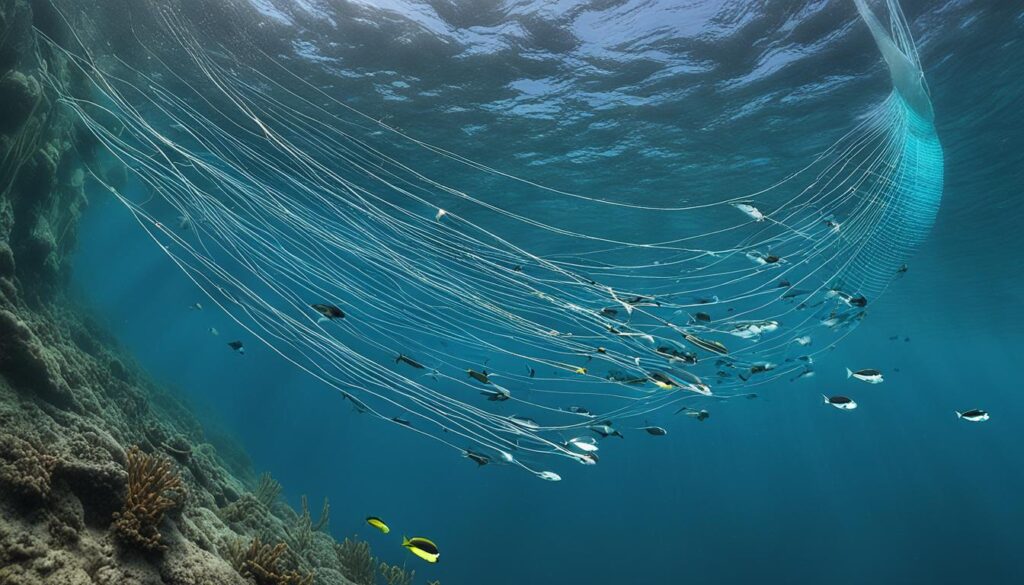Understanding fish behavior is crucial for researchers and anglers alike. By observing fish behavior patterns, conducting in-depth research, and analyzing their characteristics, we can gain valuable insights into their movements, feeding habits, and reproductive behaviors. This knowledge allows us to make informed decisions for managing and conserving fish populations, as well as improving our own fishing techniques.
In recent studies conducted at the Karolinska Institutet, researchers have focused on understanding the neural processes involved in the control of movement in fish, particularly zebrafish. By uncovering the intricate workings of the brain and how it translates thoughts into actions, scientists hope to develop therapies for spinal injuries and neuromuscular diseases in humans. The discoveries made in this research have shed light on the differences in neurons responsible for escape behavior and slow movements compared to rapid movements.
Through fish behavior studies, we are unlocking the secrets of their underwater world. From observing their behavior in their natural habitats to utilizing advanced technologies such as acoustic telemetry, we are able to track their movements, unravel their behavior patterns, and gain a deeper understanding of their ecological roles.
Key Takeaways:
- Understanding fish behavior is essential for researchers and anglers.
- Research conducted at the Karolinska Institutet focuses on the neural processes involved in fish movement control.
- Observing fish behavior in their natural habitats provides valuable insights.
- Advanced technologies like acoustic telemetry enable precise tracking of fish movements.
- Understanding fish behavior can contribute to the development of therapies for human spinal injuries and neuromuscular diseases.
The Role of Lagoons in Fish Behavior
Lagoons offer a unique fishing experience due to their specific characteristics and abundant marine life. They serve as natural nurseries for fish species during their early life stages and provide a haven for predators and prey.
Lagoons are rich in food sources, attracting larger fish in search of their next meal.
Understanding the characteristics of different lagoons, such as size, depth, and surrounding vegetation, is crucial for successful lagoon fishing. Researching the temperature range and tidal patterns of lagoons can also help anglers identify the best fishing spots and target the right fish species.
Equipping ourselves with the right fishing gear, bait selection, and proper maintenance is essential for maximizing success in lagoon fishing.
Lagoon Fishing Techniques
- Choose the right fishing rod and reel suitable for lagoon fishing.
- Experiment with different bait options such as live bait, artificial lures, or cut bait.
- Use lagoon-specific tactics like sight fishing, where you observe the water for any signs of movement or activity.
- Explore various casting techniques such as topwater casting, bottom bouncing, and trolling.
- Adapt to the conditions of the lagoon, including wind direction, tides, and water clarity.
By employing these lagoon fishing tactics, anglers can enhance their chances of a successful catch and have a memorable lagoon fishing experience.
Advancements in Acoustic Telemetry for Understanding Fish Behavior
Acoustic telemetry technology has revolutionized the study of fish behavior. By tagging fish with acoustic transmitters and using a network of receivers, scientists can track the precise movements of fish. This detailed information allows researchers to discover previously unknown aspects of fish behavior, such as spawning locations, migration patterns, and habitat use.
Acoustic telemetry has played a crucial role in studying fish species in the Great Lakes, including lake trout, lake sturgeon, and walleye. It has been instrumental in uncovering new spawning grounds for lake trout and providing valuable insights into the movement patterns of walleye.
With acoustic telemetry technology, researchers can accurately track fish movement patterns and understand how different factors, such as water temperature, depth, and availability of food, influence their behavior. This information is invaluable for improving fishery management and conservation efforts in the Great Lakes.
“Acoustic telemetry allows us to gain a deeper understanding of fish behavior by providing real-time data on their movements. This technology is a game-changer in our efforts to conserve and protect fish populations in the Great Lakes.”
By studying the intricate movements and behaviors of fish, researchers can better identify critical habitats, develop effective conservation strategies, and make informed decisions regarding fishing regulations. Acoustic telemetry technology has paved the way for advancements in fish behavior research, enabling us to unlock the secrets of these underwater creatures.
Aquatic Insights: Acoustic Telemetry Discoveries
Acoustic telemetry has revealed surprising findings about fish behavior in the Great Lakes. Here are some notable discoveries:
| Fish Species | Discovery |
|---|---|
| Lake Trout | Identification of new spawning grounds |
| Walleye | Insights into migration patterns |
| Lake Sturgeon | Understanding habitat preferences and movement patterns |
These discoveries have significant implications for fishery management, conservation efforts, and the overall understanding of fish behavior in the Great Lakes. Acoustic telemetry continues to open new doors for research and highlights the importance of preserving our aquatic ecosystems.

How Acoustic Telemetry Works
Acoustic telemetry is a sophisticated fish tracking technology that provides valuable insights into fish behavior. By utilizing acoustic transmitters and a network of strategically placed receivers, scientists can accurately monitor the movements and habits of tagged fish. Let’s explore how acoustic telemetry works in detail.
Tagging Fish with Acoustic Transmitters
Acoustic telemetry begins with tagging fish using specially designed acoustic transmitters. These transmitters emit unique sound signals, commonly referred to as “pings.” The transmitters are carefully attached to the fish, ensuring minimal impact on their natural behavior. The pings emitted by the transmitters serve as distinctive identifiers for individual fish, allowing researchers to track their movements.
Developing a Network of Receivers
To capture the pings emitted by the acoustic transmitters, a network of receivers is strategically deployed. Receivers are underwater devices equipped with hydrophones—sensitive underwater microphones that detect acoustic signals. These hydrophones pick up the distinct pings emitted by the tagged fish as they swim within the range of the receivers.
Recording and Analyzing Acoustic Data
When a receiver detects a ping from a tagged fish, it records essential data, including the date, time, and ID number of the fish. This information is crucial for tracking the fish’s movements over time and understanding its behavior patterns. Scientists collect the data from the receivers and perform in-depth analysis to uncover valuable insights.
Applications and Benefits of Acoustic Telemetry
Acoustic telemetry has numerous applications in fish tracking, research, and conservation efforts. By analyzing the data collected from the acoustic telemetry system, scientists can gain valuable insights into fish behavior, including migration routes, habitat preferences, and spawning locations. This information is crucial for fisheries management and conservation practices. Moreover, acoustic telemetry helps researchers monitor the effectiveness of fishery protection measures and evaluate the impact of environmental changes on fish populations.
Acoustic telemetry is widely used in the Great Lakes region, particularly with the implementation of the Great Lakes Acoustic Telemetry Observation System (GLATOS). This system comprises over 400 receivers strategically positioned throughout the Great Lakes and thousands of tagged fish contributing to valuable research and conservation efforts.
By harnessing the power of acoustic telemetry, scientists and conservationists can better understand fish behavior, make informed decisions about fishery management, and ultimately contribute to the sustainable future of fish populations. The insights gained from this technology pave the way for more effective conservation strategies and improved ecosystem management.
| Benefits of Acoustic Telemetry | Applications of Acoustic Telemetry |
|---|---|
| 1. Accurate tracking of fish movements | 1. Studying fish migration patterns |
| 2. Understanding fish habitat preferences | 2. Identifying critical spawning areas |
| 3. Monitoring the effectiveness of fishery protection measures | 3. Evaluating the impact of environmental changes |
| 4. Enhancing fish population management | 4. Guiding conservation efforts |
Acoustic telemetry is a powerful tool that continues to advance our understanding of fish behavior and contribute to the conservation and sustainable management of our aquatic ecosystems.
Discoveries and Applications of Acoustic Telemetry in the Great Lakes
Acoustic telemetry has revolutionized our understanding of fish behavior in the Great Lakes, leading to numerous discoveries and applications. Through the use of acoustic transmitters and a network of receivers, researchers have gained valuable insights into the movement patterns and conservation needs of fish species in this region.
One significant discovery enabled by acoustic telemetry is the identification of new spawning grounds for lake trout. By tracking the movements of tagged fish, scientists have uncovered previously unknown spawning locations, providing crucial information for fishery management and conservation efforts. This knowledge allows us to protect and restore essential habitats for lake trout reproduction, ensuring the long-term sustainability of this iconic species.
Acoustic telemetry has also shed light on the migration patterns of lake sturgeon in the Great Lakes. These ancient and endangered fish undertake long-distance movements for spawning and feeding. By tracking their precise movements, researchers can identify critical migration routes and habitats, facilitating targeted conservation initiatives to protect these valuable fish populations.
Understanding walleye migrations is another area where acoustic telemetry has proven valuable. Through the use of acoustic transmitters, researchers have tracked the movements of walleye during their spawning migrations, providing crucial data for effective fishery management and conservation planning. This knowledge helps us predict and address potential challenges and ensure healthy walleye populations for future generations to enjoy.
Furthermore, acoustic telemetry has played a crucial role in improving control measures for sea lamprey, a highly destructive invasive species in the Great Lakes. By studying the movement patterns and behavior of sea lamprey, researchers can develop more targeted and efficient methods for controlling their populations, protecting native fish species and promoting ecosystem health.
We have only scratched the surface of the potential applications of acoustic telemetry in the Great Lakes. By understanding the behavior and movements of fish species in this vast freshwater ecosystem, we can develop more effective conservation and management strategies. Acoustic telemetry data has already helped identify critical habitats, fine-tune artificial spawning reefs, and inform fishing regulations, benefiting both fish and the communities that depend on them. We invite anglers to join us in this effort by returning tags from walleye and lake trout, providing valuable data for ongoing research and further discoveries.

Understanding Fish Behavior: Unraveling the Mysteries
Understanding fish behavior is a fascinating and crucial area of research in the field of fisheries. With advancements in technologies like acoustic telemetry, scientists have made significant strides in unraveling the mysteries of fish behavior. By studying fish movement patterns, feeding habits, and spawning behaviors, we gain valuable insights that can help us effectively manage and conserve fish populations.
Through fish behavior research and studies, we are able to better understand how fish interact with their environment and make informed decisions regarding their welfare. This knowledge can also contribute to the development of therapies for human spinal injuries and neuromuscular diseases. By delving into the intricacies of fish behavior, we not only improve our interactions with aquatic ecosystems, but also strive towards ensuring the sustainable future of fish populations.
As we continue to explore and deepen our understanding of fish behavior, we unlock a wealth of information that has the potential to enhance our conservation efforts, inform fishing regulations, and protect the delicate balance of our marine ecosystems. By investing in fish behavior research and studies, we pave the way for a harmonious coexistence with the fascinating creatures that inhabit our waters.
FAQ
What is the importance of understanding fish behavior?
Understanding fish behavior is crucial for researchers and anglers as it provides insights into movement patterns, feeding habits, and spawning behaviors. This knowledge helps in managing and conserving fish populations and can contribute to therapies for human spinal injuries and neuromuscular diseases.
How do lagoons play a role in fish behavior?
Lagoons serve as natural nurseries for fish species during their early life stages and provide a haven for predators and prey. Their specific characteristics and abundant marine life make them rich in food sources, attracting larger fish. Understanding lagoon characteristics such as size, depth, and surrounding vegetation is essential for successful lagoon fishing.
What advancements in technology have revolutionized the study of fish behavior?
Acoustic telemetry technology has revolutionized the study of fish behavior. By tagging fish with acoustic transmitters and using a network of receivers, scientists can track the precise movements of fish, uncovering previously unknown aspects of their behavior such as spawning locations, migration patterns, and habitat use.
How does acoustic telemetry work?
Acoustic telemetry works by tagging fish with acoustic transmitters and using a network of receivers. The transmitters emit unique pings that are detected by the receivers, which record the date, time, and ID number of the tagged fish. By analyzing the data from the receivers, scientists can determine fish presence, absence, and movement patterns.
What are some discoveries and applications of acoustic telemetry in the Great Lakes?
Acoustic telemetry has led to numerous discoveries in the Great Lakes, including the identification of new spawning grounds for lake trout and insights into the movement patterns of walleye. This technology has also improved control measures for sea lamprey and helped identify critical habitats, inform fishing regulations, and fine-tune artificial spawning reefs.
How does understanding fish behavior help unravel the mysteries of the underwater world?
Understanding fish behavior through research and studies provides valuable insights into the intricate world of aquatic ecosystems. It allows us to improve our interactions with fish populations, develop more effective conservation and management strategies, and ensure a sustainable future for these species.




